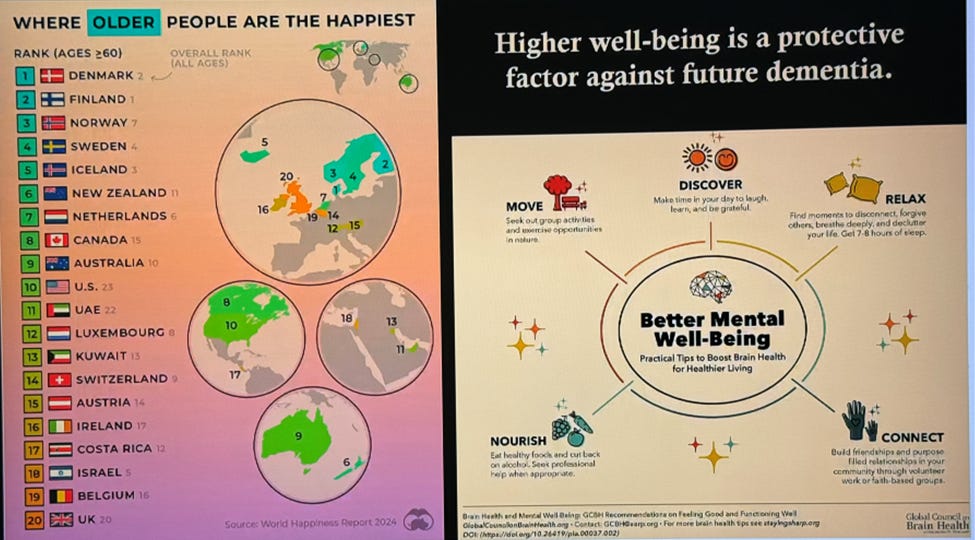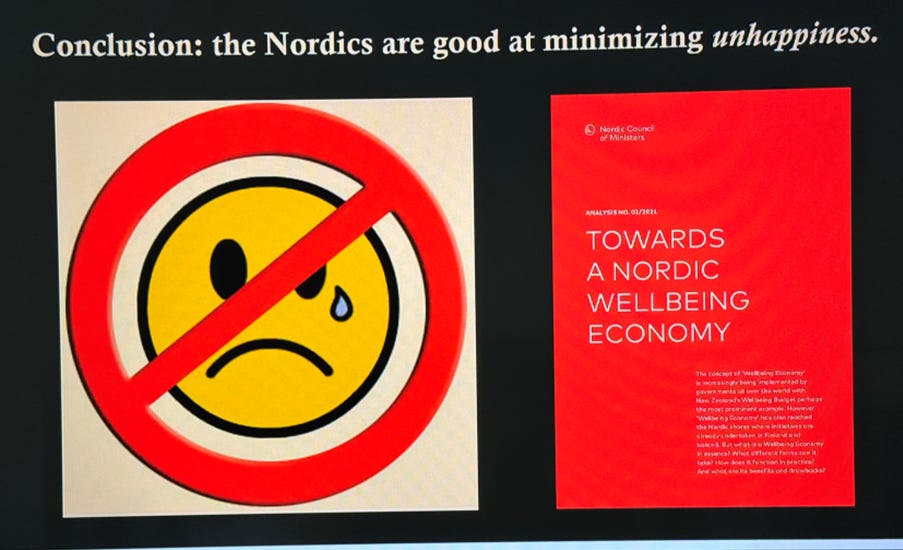A Day at Sea Means More Lectures and a Port Talk
The rough seas which caused the captain to skip the Shetland Islands are getting rougher as we head for the Faroe Islands. The swells are 15 feet, with high winds.
We haven’t experienced seas this rough in all five months at sea this year. Rita and I each consumed a chewable Dramamine both last night and today. So far, so good. There’s probably a run on the green apples which the ship supplies to combat sea sickness.
We slept okay last night despite the rough seas and went to the World Cafe for both breakfast and lunch. We’re skipping dinner to avoid the lengthy walk, which is the full length of the rolling ship. We’re near the bow, and the World Cafe is at the stern.
The 9:30 a.m. lecture was Dr. Stan Carpenter on the “History of Scandinavia,” reiterating for the most part what we have already learned from multiple lectures and guides. The 11 a.m. lecture by Mark Fitzpatrick was really interesting. “Why Are They So Happy?” was about why all four Nordic countries — Denmark, Norway, Finland and Sweden — consistently rank highest in measures of popular happiness. It was very instructive. Here are a few of my favorite slides:
By the way, the highest tax bracket in Norway is 38%, comparable to the other Nordic countries. The highest bracket in the U.S. prior to Pres. Reagan’s 1981 tax cut was 70%. However, there’s a 25% Value Added Tax (VAT), which is essentially a sales tax on goods, 14% on food, but it’s included in the price of goods, not added at checkout. Prices didn’t seem much higher than we’re used to in Denver, however.
Two key points, in my opinion, were that (1) Scandinavian countries have no feudalism or serfdom/slavery in their past to color relationships with government and within the population, and trust in government is high; and (2), this:
Scandinavian countries minimize unhappiness with their social safety net, free healthcare throughout one’s life; and free education through college and graduate school, so no tuition debt hangs over young adults as they enter the work force. There is virtually no homelessness — only among people who migrate to Scandinavia because of its social safety net. I can only remember spotting two persons on the street who appeared to be homeless or seeking handouts. Retirement age is 67, and everyone gets a pension.
Of course, Norway is a special case. It is the richest nation per capita in the world thanks to its oil and gas income from the North Sea. It was only by chance that Norway exercised its right to expand its territorial waters from 12 miles to 200 miles, encompassing the entire North Sea oil reserves, prior to those reserves being discovered. Because there is no government corruption, and because the government was smart about requiring 50/50 partnership with foreign oil companies wanting to drill for oil, all the revenue from oil flows into a national trust for the public good called the Government Pension Fund Global, which is now worth over $5 trillion, which is about $1 million per capita, one guide told us. Most of the fund’s growth is from investments made by the fund outside Norway. Here’s a paragraph from the web page linked above:
The fund is now one of the world’s largest funds, owning almost 1.5 percent of all shares in the world’s listed companies. This means that we have holdings in around 9,000 companies worldwide, entitling us to a small share of their profits each year. In addition, the fund owns hundreds of buildings in some of the world’s leading cities, which generate rental income for us. The fund also receives a steady flow of income from lending to countries and companies. By spreading our investments widely, we reduce the risk of the fund losing money.
Only 3% of the value of that fund goes to the country’s general fund, as I recall being told, and that has funded the amazingly good social safety net and infrastructure of the country when combined with the income tax and VAT. No wonder the population is happy. What, them worry?
Visitors are curious about the dark and cold winter in Norway. Although Bergen is warmed like the rest of Europe by the Gulf Stream and gets mostly rain year round, inland and up north the snow can be intense — maybe 2 meters deep at the height of winter — and there is 24-hour nighttime above the Arctic Circle. Even in southern Norway and Sweden the sun never gets far above the horizon from late morning to early afternoon in mid-Winter. Does that cause Seasonal Affective Disorder? Guides we asked said this is not a problem, and I found the following article online that goes into the why and how of that: A Scandinavian explains hygge — and how to make it through winter | Vox.
Our guide for Wednesday’s bus tour of waterfalls, Bas, is a native of the Netherlands and has lived in numerous countries from Brazil to Vietnam, and he plans to leave Norway in October for warmer, sunnier climes. A tourist store we saw on Wednesday had a sign stating that they are closing for the season on September 15th, and we were told that despite our mostly shirtsleeve weather during our four days in Bergen, winter arrives by the end of September. That relates to the Stockholm-Montreal cruise we are now on — it’s referred to as a “repositioning” cruise, in which this ship goes to North America where it will focus on more southern itineraries, beginning, I suspect, with a New England cruise focusing on shore excursions to see the fall colors.
At 4:30 we watched the port talk about Torshavn, our port of call in the Faroe Islands and also its capital. We’re doing a 2-hour bus tour of a couple islands. Most of the islands are connected by tunnels, and one of those tunnels from Torshavn contains the world’s first undersea roundabout. Here’s a picture I found online:
At 6:30, Dr. Claudia Hackbarth delivered her first lecture of this cruise on the subject of “Doggerland: Atlantis of the North?” Unlike mythical Atlantis, Doggerland is a true sunken land. It was exposed during the last ice age which, like all ice ages, caused the sea level to fall by a few hundred feet due to evaporation from the sea being deposited as snow which didn’t melt, creating glaciers. Doggerland connected what we know as England to the mainland. Basically it’s the North Sea, now that the ice age ended and the sea rose again. It was a fascinating lecture. Skeletons of wooly mammoths and other land animals on the sea floor proved that the sea floor was above ground and habitable during the most recent ice age, which began 21,000 years ago. Wikipedia will tell you more about Doggerland.
The Viking Vocalists performed a set of Motown songs in the Star Theater at 9:00, but we missed it. Unfortunately, those performances are not recorded for later viewing on our stateroom TV.
Bye for now.












